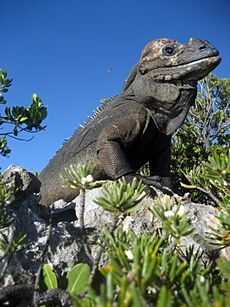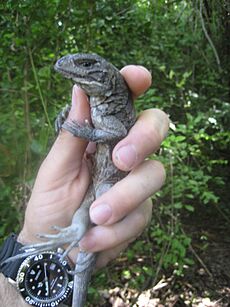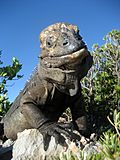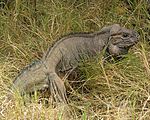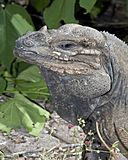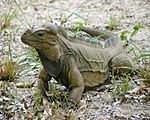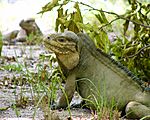Mona ground iguana facts for kids
Quick facts for kids Mona ground iguana |
|
|---|---|
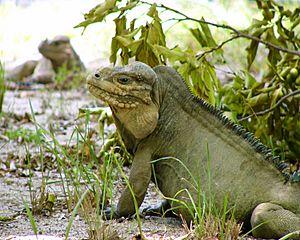 |
|
| Conservation status | |
| Scientific classification |
|
| Kingdom: | Animalia |
| Phylum: | Chordata |
| Class: | Reptilia |
| Order: | Squamata |
| Suborder: | Iguania |
| Family: | Iguanidae |
| Genus: | Cyclura |
| Species: | |
| Subspecies: |
C. c. stejnegeri
|
| Trinomial name | |
| Cyclura cornuta stejnegeri Barbour & Noble, 1916
|
|
| Synonyms | |
|
Cyclura stejnegeri Barbour & Noble, 1916 |
|
The Mona ground iguana (Cyclura cornuta stejnegeri) is a special kind of rock iguana. It is a subspecies of the rhinoceros iguana. This means it's a unique group within the rhinoceros iguana family.
These iguanas live only on Mona Island in Puerto Rico. When an animal lives only in one place, it is called endemic. The Mona ground iguana is the largest native lizard that lives on land in Puerto Rico.
Contents
About the Mona Ground Iguana
The Mona ground iguana belongs to a group of lizards called Cyclura. Two scientists, Thomas Barbour and G.K. Noble, first named it as its own species in 1916. Later, in 1937, Barbour decided it was a subspecies of Cyclura cornuta.
The name cornuta comes from a Latin word meaning "horned." This refers to the horn-like bumps on the noses of the male iguanas. The subspecies name, stejnegeri, honors Leonhard Hess Stejneger. He was a scientist who thought this might be a new species back in 1902.
Scientists still discuss if this iguana is a true subspecies or a completely different species. Some call it Cyclura stejnegeri. Others think it's just a regional type of the main C. cornuta species.
Appearance and Features
The Mona ground iguana is a large lizard with a heavy head and strong legs. Its tail is flat from side to side. These iguanas can grow up to 1.22 m (4 ft 0 in) (about 4 feet) long, from their nose to the tip of their tail. They have a crest of pointed, horn-like scales that runs from their neck to their tail.
Their color is usually a plain gray or olive green. Sometimes, they have slight brown or blue shades. Young iguanas look different from adults. They have gray stripes across their bodies. These stripes stay until they are about three years old, when they become adults.
Male iguanas have bony bumps on their snouts that look like horns. They also have thick pads on the back of their heads and large dewlaps (flaps of skin under their chin). Male and female iguanas look different from each other. This is called sexual dimorphism. Males are bigger than females. They also have bigger crests, "horns," and special pores on their thighs. These pores release pheromones, which are chemical signals.
Habitat and Home
Mona ground iguanas are diurnal, meaning they are active during the day. They spend most of their day sunbathing to save energy. As mentioned, they live only on Mona Island in Puerto Rico.
These iguanas can be found all over the island. However, they use the southwest part of the island mostly during nesting season. They spend a lot of their lives underground. You can often find them in rocky slopes, caves, and deep holes in the ground. They can be found about 1.5 m (4 ft 11 in) (about 5 feet) deep underground.
Reproduction and Life Cycle
Even though Mona ground iguanas live across the whole island, only about 1% of the land is good for nesting. This special area is on the southwest coast. It has loose sand and gets direct sunlight, which is perfect for incubating eggs. Females bury their eggs in the sand, and the sun helps them hatch.
Males become ready to mate when they are about 28–31 cm (11–12 in) (11-12 inches) long from snout to vent. This usually happens when they are three to four years old. Females mature a year later, when they are about 35–40 cm (14–16 in) (14-16 inches) long.
Nesting season starts in the second week of June. During the two weeks of mating season, one female might mate with more than one male. After about a month, the females start digging their nests. They dig a tunnel about 3 ft (0.91 m) (0.9 meters) long, one to two feet underground. Here, they lay between five and 19 eggs, with 12 eggs being the average.
Females will guard their nests for a few days. However, they do not care for the hatchlings once they emerge. The eggs hatch about three months later. Newborn hatchlings are usually about 32 cm (13 in) (12.5 inches) long and weigh about 73.7 g (2.60 oz) (2.6 ounces). They grow about 5.23 cm (2.06 in) (2 inches) each year.
What They Eat
Mona ground iguanas, like most Cyclura species, are mainly herbivores. This means they mostly eat plants. Their diet includes leaves, flowers, berries, and fruits from many different plants.
A study in 2000 by Dr. Allison Alberts from the San Diego Zoo found something interesting. Seeds that pass through the iguanas' digestive system sprout faster than those that don't. This helps the plants, especially since Mona Island has very short rainy seasons. The iguanas also help spread these seeds to new areas, especially when females travel to nesting sites.
Since they are the largest native herbivores in their ecosystem, Mona ground iguanas are very important. They help keep the balance between the climate and the plants on the island. Sometimes, they also eat insect larvae, crabs, slugs, dead birds, and fungi. They are known to eat the caterpillars of sphingid moths. These caterpillars eat poisonous plants and have bright colors that warn other animals to stay away.
Endangered Status
There are about 1,500 Mona ground iguanas left. Their numbers are lower than on other islands where similar iguanas live in the West Indies. There are also very few young iguanas, making up only 5-10% of the population. This shows that the population is getting older and shrinking.
Why Their Numbers Are Declining
Wild pigs are the biggest threat to these iguanas. Pigs dig up iguana nests, and Mona ground iguanas often nest close together in large groups. Goats and pigs that were brought to the island also compete with the iguanas for food. Goats eat too many plants, which means less hiding places for young iguanas. This makes it easier for birds like the osprey and wild cats to catch them.
Efforts to Help Them Recover
A special program called "headstarting" was started in 1999. The Puerto Rico Department of Natural and Environmental Resources, along with groups like the IUCN Iguana Specialist Group, the US Fish and Wildlife Service, the Toledo Zoo, and the University of Puerto Rico, are all working together.
In this program, young iguanas are raised in a safe place until they are big enough to survive in the wild. At this size, predators like pigs and wild cats are no longer a threat. Before releasing the iguanas, they also get health checks. These checks help scientists understand the iguanas' normal health. This way, they can spot any future problems from parasites or diseases that might harm the population.
- Gallery of the Mona ground iguana
See also
 In Spanish: Iguana de Mona para niños
In Spanish: Iguana de Mona para niños



